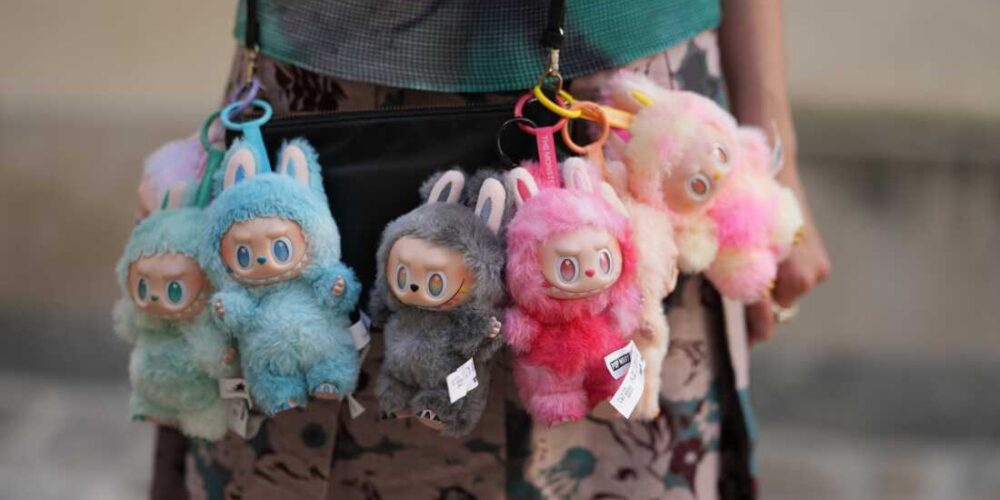Forbes magazine is calling them a “good investment”, a “strong market collectible for years to come”. From K-pop superstars Blackpink, to Karl Marx’s grave in London’s Highgate Cemetery, Labubus (small, rabbit-eared plush toys) are taking the world by storm. With the rarest varieties selling for up to $150,000, fans have taken to travelling overseas, queuing for hours, and even all-out brawls in order to get their hands on the figurines
Beyond a genuine passion for the toothy-grinned little creatures, their buyers view Labubus as an investment, both in their own social capital, and in the chance to win big, bag a rare Labubu, and resell for a handsome profit. Labubus are a symptom of late-stage capitalism, more of a gamble than a plaything.
These are far from the first ugly plastic toys to become a global craze, following in the diminutive footsteps of the likes of the US-owned Funko Pop, Beanie Baby, and Furby brands, to name just a few. Yet at a time of waning US Empire, the Chinese-owned and manufactured Labubus may represent the first time a trend from the People’s Republic has attained such global popularity.
For decades, China has been the centre of the global toy industry. Producing over 70% of the world’s toys, the “Made in China” stamp has been an indelible part of millions of childhoods since the boom in Chinese industry in the 1970s. Under former leader Deng Xiaoping’s “Reform and Opening Up” policy, the essential components or “commanding heights” of the Chinese economy were kept under state control, while less-vital industries were allocated to private hands. Toys fell squarely on the non-essential, capitalist side of the divide.
While China has since seen massive development and the elimination of extreme poverty, the shift has also allowed corporations to accumulate unprecedented capital. PopMart, the Beijing-based Labubu manufacturer, has reported a soaring 350% increase in profits since the dolls went viral. The Labubu craze is therefore both a product of growing Chinese soft power, and an example of predatory capitalism.
Marx, Lenin, Luxemburg, and other giants of socialist theory frequently spoke of capitalism’s need to constantly seek out new markets to compensate for the crisis of overproduction, where the supply of goods would exceed the purchasing power of workers. Yet Labubus are perhaps better understood as a crisis of overconsumption. Under neoliberalism, individuals are reduced to mere market actors, making consumerism the only avenue left to express ourselves and demonstrate our belonging to the in-group. While contemporary capitalism is rapidly approaching the limits of new markets to exploit, Labubus are a sign that capital can create demand out of nothing, even for vaguely unsettling vinyl elves.
Of course, this overconsumption comes at a material cost. Labubus are a fleeting trend, a means for young workers to invest their hard-earned wages into momentary social capital. When this fad has reached its natural conclusion, they will be relegated to landfills like all the must-have toys before them. Yet these discarded Labubus will remain long after we are gone, forming a layer in the sediment of neoliberalism, demarcating the boundaries of brainrot capitalism.
In Capitalist Realism, Mark Fisher argues that teenagers are uniquely capable of navigating the messaging onslaught of late-stage capitalism. “Slogan recognition”, Fisher contends, “is sufficient to navigate the net-mobile-magazine informational plane”. Labubus, with their nonsensical name and bizarre memes, have become a kind of slogan unto themselves. Beyond the endorsements from the likes of Kim Kardashian, Dua Lipa, and David Beckham, Labubus have reached the top spot of global popularity by integrating themselves into the infinite scroll of TikTok takedowns and Instagram reel memes.
Labubus have adopted sales tactics well-suited to our game-ified neoliberal era. PopMart sells the dolls in “blind boxes”, with buyers not knowing which of the plastic monsters they have purchased until opening. Combined with limited edition series, and rare, “secret” Labubus, the toys are marketed to maximise collectability – and resale value. Like the proliferation of online gambling apps, pay-to-win and lootboxes in video gaming, and pump-and-dump crypto scams, Labubus are designed to fulfil a desire, but never provide satisfaction. In capitalist realist terms, the Labubu craze is designed to feed upon the quintessential figure of late-stage capitalism, the “debtor-addict”.
Many of the Labubus’ biggest fans are not children, however, but adults. The popularity of these plastic monsters among young adults speaks to the state of extended adolescence neoliberal capitalism has imposed upon this generation. Under the housing crisis, and the falling purchasing power of inadequate wages, the typical milestones of growing up, like living independently and raising children, are increasingly out of reach to an entire generation. More than hunks of forever plastics, Labubus presents the potential to return to a simpler time in the lives of many.
Under the predation of contemporary neoliberalism, in the midst of a climate catastrophe, is it any surprise then that these generations will cling to a symbol of childhood, when the contradictions of capitalism were not so existential or acute?






